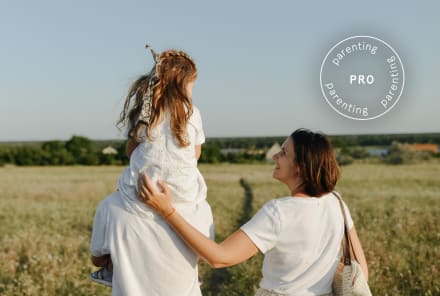Advertisement
How to Set Kind Boundaries While Your Children Are Still Babies


"Freedom within limits" is how we help our Montessori children develop self-discipline, and, like other ideas, we start with this at birth. We try as much as possible to give the baby freedom within the limits of safety and their abilities.
Offering our baby choices, giving time and opportunity for movement and activity, and letting them feed themselves are some of the ways that we give our baby freedom. "Freedom" can be a difficult word to understand, as we are often used to it meaning "freedom from" something, like rules or having to work. In a Montessori context, we give the baby and child "freedom to" do something—like freedom to choose, to move, and to express themselves. It's not a license to do whatever they like—it's freedom within the rules of our family and society.
How to set kind boundaries.
So with all of these, we also set limits or boundaries. Here are some of the ways that we set boundaries with babies:
Limit the options or choices.
When preparing the baby's environment, we consciously only include the items that are safe for them to use. When we offer choices, we limit them to options that we have approved and that are acceptable to us.
Keep them safe or give safe alternatives.
Babies are still getting to understand the world. They do this by exploring, and sometimes they will explore beyond the safe areas of the home or space or do things that are unsafe. In these situations, we can stop unsafe behavior and redirect unacceptable actions.
For example, if a baby crawls to an electrical outlet, we tell them it is unsafe and carry them to a safe part of the room. A baby who is throwing inappropriate objects can be redirected to a basket of balls or objects more appropriate for throwing.
Respond to the need or message being communicated.
The baby's behavior is usually their way of communicating something. It might be a need or a message. A baby who is throwing objects might be communicating a need for more gross-motor movement, and a baby who is throwing food might simply be communicating that they are full or not interested in the meal. Our response would be based on our observation and interpretation.
Modify the environment or a process.
If our baby often pours the water out of their cup while they're not drinking, we can modify our process by keeping the cup by our side until it is time for the baby to drink or pouring just enough for one drink and taking the cup back once the baby is done. If our baby keeps going back to an electrical outlet, we can make sure it is protected or maybe move a piece of furniture in front of it. In this way, we set limits using the environment.
Be prepared to repeat ourselves.
We have only a few limits because we will need to repeat ourselves many times until our baby's will is developed enough to stop themselves, for example, from touching something they want to explore. Their prefrontal cortex, which is responsible for inhibiting themselves, is in the earliest stages of development and will be developing into their early 20s. So we need to be their prefrontal cortex. Teach them what to do rather than tell them what we don't want them to do: Remembering that babies are new here and just figuring out how things work, we can see ourselves as their guides, here to help them and show them how things work.
With this in mind, when the baby goes beyond our boundaries or limits, we can see this as an opportunity to teach them appropriate and acceptable behavior. This understanding can make a difference in how we respond. If we are teaching the baby what is acceptable, we might say. "The water stays in the cup. Put the cup down here," instead of "Don't pour the water," or "Why do you keep pouring the water?"
We might model like this: "I see you are done. Let me show you where the cup goes." Modeling is so important in helping the baby figure out the boundaries.
A final note on positive language.
This is a great time for us to practice saying things in a more positive way. Children tune out when they constantly hear "don't" and "no" all the time. So we tell them what we want them to do: "Let's keep your feet on the ground" rather than "Don't climb on the table." In addition, it's simpler for them to process our request. When we hear someone say, "Don't put your hands on your head," first we think of our head and then need to work out where to put our hands instead. Start now, and by the time they are toddlers and we are seeking their cooperation more and more, it will be automatic.
Watch Next
Enjoy some of our favorite clips from classes
Enjoy some of our favorite clips from classes
What Is Meditation?
Mindfulness/Spirituality | Light Watkins
Box Breathing
Mindfulness/Spirituality | Gwen Dittmar
What Breathwork Can Address
Mindfulness/Spirituality | Gwen Dittmar
The 8 Limbs of Yoga - What is Asana?
Yoga | Caley Alyssa
Two Standing Postures to Open Up Tight Hips
Yoga | Caley Alyssa
How Plants Can Optimize Athletic Performance
Nutrition | Rich Roll
What to Eat Before a Workout
Nutrition | Rich Roll
How Ayurveda Helps Us Navigate Modern Life
Nutrition | Sahara Rose
Messages About Love & Relationships
Love & Relationships | Esther Perel
Love Languages
Love & Relationships | Esther Perel
What Is Meditation?
Box Breathing
What Breathwork Can Address
The 8 Limbs of Yoga - What is Asana?
Two Standing Postures to Open Up Tight Hips
How Plants Can Optimize Athletic Performance
What to Eat Before a Workout
How Ayurveda Helps Us Navigate Modern Life
Messages About Love & Relationships
Love Languages
Advertisement

The 4 Pillars That Lead To Long-Lasting Relationships, From A Marriage Counselor
Rachel Glik, Ed.D., LPC

The 4 Pillars That Lead To Long-Lasting Relationships, From A Marriage Counselor
Rachel Glik, Ed.D., LPC















